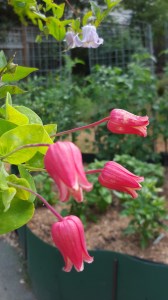
Clematis texensis, a species clematis from the river banks of Texas.
What a summer we had this year! Zero rain coupled with excessive heat (at least as far as Seattleites are concerned). Blech! I didn’t have the spirit to venture into the garden half the time because so many plants, clematis included, were suffering–in spite of irrigation (as much as I could afford, anyway).
Even so, I managed to take a few photos in my hot and arid Pacific Northwest garden (sounds like an oxymoron!). The standouts in July turned out to be the heat-loving Clematis texensis clan, including the first flowers from my first-to-bloom C. texensis species (see photo). The tulip-shaped blossoms in the species range from scarlet to dark pink, with white, red, or yellow coloring on the inside of the petals. Blooming above C. texensis in this photo are the light blue bells of another species, C. crispa.
In the late 1800s European hybridizers loved the red color and tulip shapes of the blossoms of C. texensis and used it extensively in their hybridizing programs. More than one clematis expert has told me that almost all red and dark-pink clematis are descended from C. texensis!
Also blooming in my garden in July were two texensis hybrids : C. Ville de Lyon climbing up a Decaisnea tree (also called Dead Man’s Fingers for it’s steely blue finger-like seed pods) and C. Catherine Clanwilliam.

Clematis Ville de Lyon, a C. texensis progeny originally hybridized in France in the late 1800s.

Clematis Catherine Clanwilliam, another child of C. texensis, this one hybridized more recently by British hybridizer, Barry Fretwell.